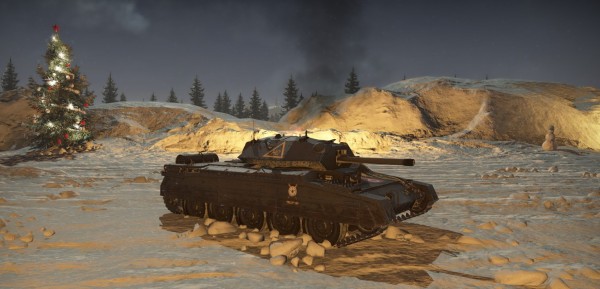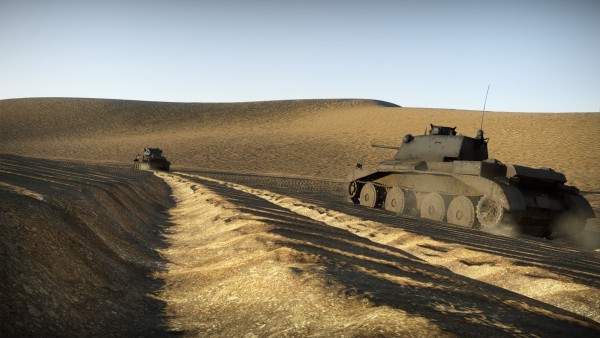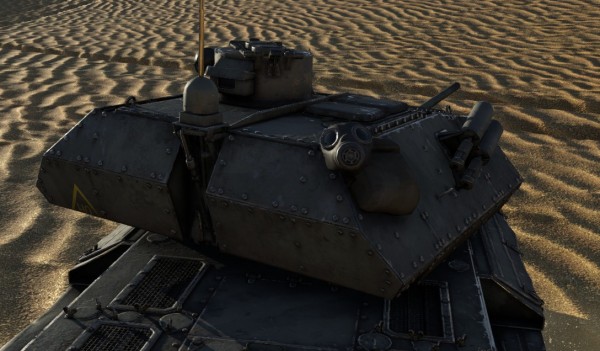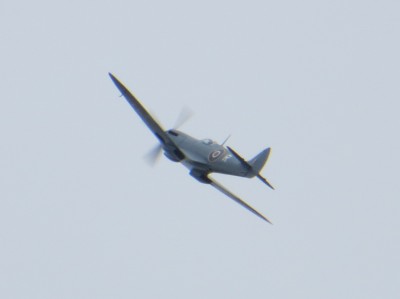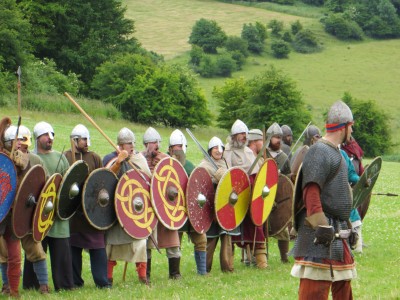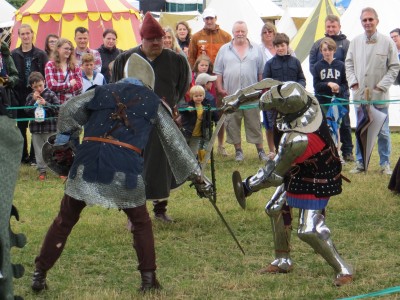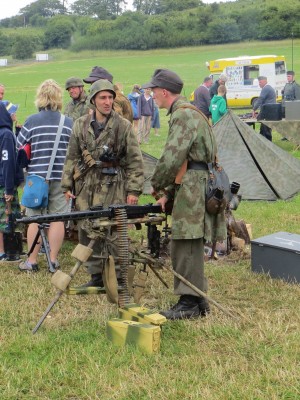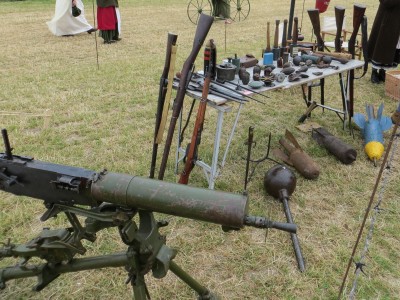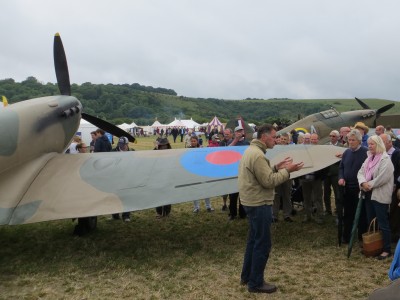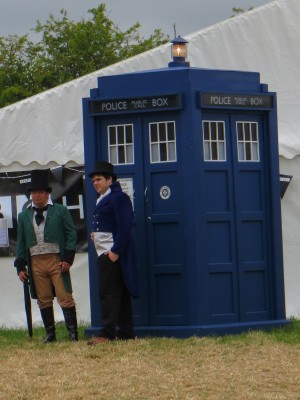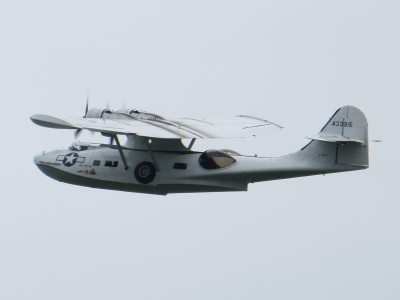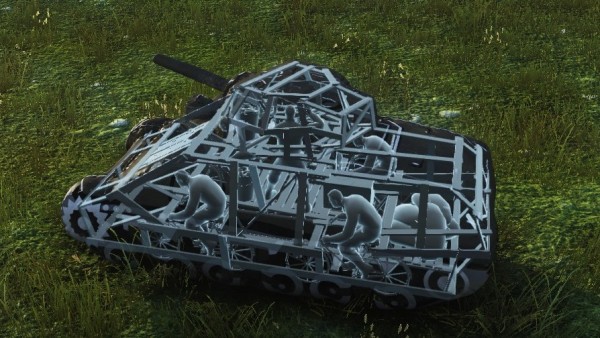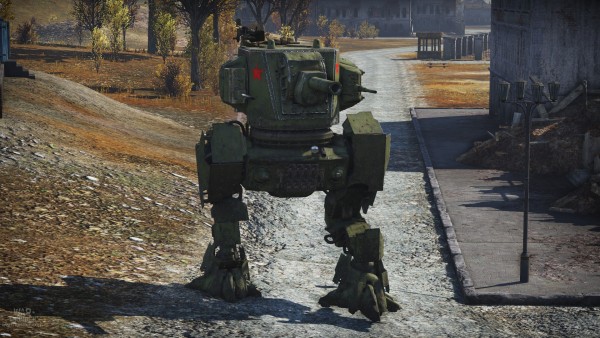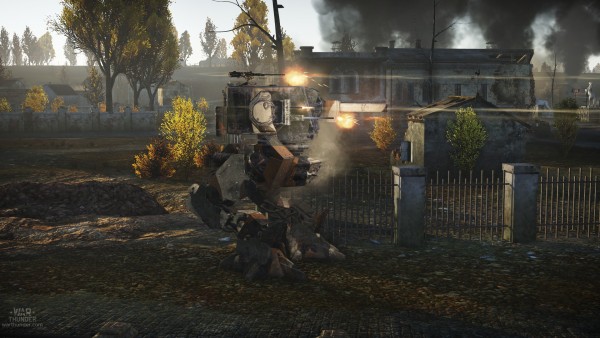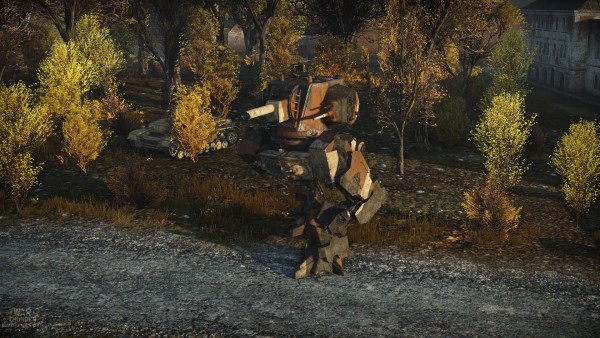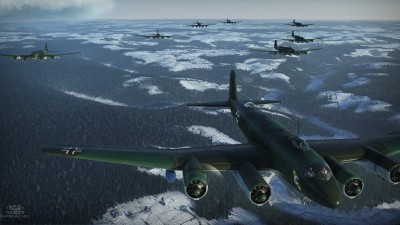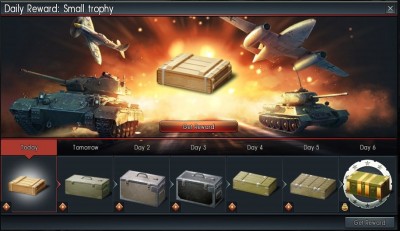Season’s greetings, one and all, may 2016 bring you joy, wealth and lashings of hats.
Not a charitable organisation, much though the evidence may point to our being reasonably tall
Friday, 25 December 2015
Wednesday, 16 December 2015
War Thunder Update 1.55
Put the kettle on, chaps, time for tea! War Thunder has, thankfully, added British tanks before the French, and a splendid job they’ve made of them. Along with the tanks (being gradually unlocked for testing, unless you buy one of the British premium packs) are new maps for recreating the triumphs (and not-quite-such-triumphs) of the 8th and 1st Army in North Africa, El Alamein and Tunisia, and very nice they look too:
There are also a few new aircraft and assorted other tweaks, but the British tanks are the main attraction. Tally ho, death or glory!
Monday, 7 December 2015
Reviewlet: Detectorists
Some readers may remember, from the dim, distant days of 2008, the BBC series Bonekickers, a rather silly bit of Da Vinci Code-esque nonsense, in which a team of archaeologists tackled mysteries of the past with devastating implications in the present, with hilarious consequences (albeit not intentionally hilarious). Luckier readers may have forgotten about it until just now, in which case I’m terribly sorry for bringing it up again; if you missed out then you could hasten to your nearest videographic media vending emporium, who are sure to stock such a popular title, or maybe just check out a recap here.
The reason I dig up the past like some maverick archaeologist is that the BBC 4 series Detectorists is also, in the broadest terms, about looking for old stuff, but in almost every other way is the very opposite of Bonekickers, as if they were series created in mirror dimensions (Bonekickers would definitely be the one with the beard and eye patch). Written and directed by Mackenzie Crook, Detectorists is centred around the members of the Danebury Metal Detecting Club, in particular Andy (Crook) and Lance (Toby Jones). It’s a beautiful, slow-paced comedy about people, hobbies and relationships, the tone set by Johnny Flynn’s fantastic theme. Though, in the grand scheme of things, not an awful lot happens (I don’t think it’s too much of a spoiler to say that at no point do they find an artefact revealing a centuries-old conspiracy concealed by shadowy individuals who secretly run the world), the half-hour episodes just fly by. The second series, just finished, has been an absolute highlight of this year’s television. Five ring pulls out of five (Quatro… or maybe Lilt…)
Tuesday, 24 November 2015
In Our Time Lord
Talking to Melmoth about the In Our Time podcast, in which Melvyn Bragg hosts three academics to discuss ideas from science, history, philosophy, culture and religion, I mentioned that while Bragg is more than at home discussing arts and literature, in science-heavy episodes like “P vs NP” he takes on something of a “Doctor Who Assistant” role, keeping things grounded for the audience as the academics roam through theoretical fields of incomprehensible dimensions
Melmoth pointed out that, with Jenna Coleman leaving Doctor Who, there could be an *actual* Doctor Who Assistant vacancy coming up, and perhaps Melvyn Bragg could take on the role. I think that would be a stroke of genius, Capaldi & Bragg could roam through space and time, investigating mysteries, defeating invasions, and completely transforming In Our Time…
“So, Professor Harlow, how accurate is Thucydides’ account of the Peloponnesian War?”
“Well, Melvyn, we have some fragmentary corroborative evidence of certain events, but we can’t possibly know if Thucydides actually witnessed…”
“Hang on, I’ll ask him. Back in a jiffy.”
*VWOORP* *VWOORP* *VWOOORP*
“Right, well, it turns out that most of it is artistic license, had a fascinating chat with Nicias, lovely chap, look, I got a selfie with him. Oh, and the beings the Greeks worshipped as gods were actually Thorgruns from Planet Frinksnarf who manipulated the Spartans into invading Attica, but the Doctor and I sorted them out. Incidentally, if anyone’s doing any archaeological work around Sicily, could you keep an eye out for my car keys? I think I dropped them in the siege of Syracuse…”
Monday, 2 November 2015
Everything Old is New Again
Time flies by, and not just when you’re the driver of a train (whether or not speeding out of Trumpton with a cargo of illicit narcotics). War Thunder celebrated its third anniversary over the weekend with a mini-bonanza of sales and small-scale challenges every three hours (win two matches, destroy five tanks etc), which worked rather well for dipping in and out of, rather than settling down to one big task and burning out. I’m still dropping in to War Thunder for a match or two most days, having been in since more or less the start, pretty good longevity really. I’ve also been playing a lot of World of Warships, but getting to tiers V, VI and VII the grind is really beginning to kick in, it’s feeling a lot like World of Tanks back in the day. Course War Thunder gets terribly grindy as well in the high tiers, I’m chipping away slowly at unlocking new jets, but I just enjoy the air battles there. WoWS is rather more variable, for every decent fight I seem to end up in a one-sided loss where most other ships are two tiers higher, or our team manage to lose about five ships before inflicting any sort of damage, or we win handsomely but I get taken out by a fluke magazine explosion in the first salvo. I’ll probably scale things back a bit there, and wait for the Royal Navy to turn up.
Going right back to the early days of PC gaming with Wolfenstein, I also just picked up the reboot, The New Order, in a Humble sale. It’s pretty interesting so far, strong atmosphere and plays well, even if the central character hasn’t developed much of a personality past the blocky portrait from the original. I’d been toying with picking up Fallout 4 on release, but with plenty else to play I might give it a little while for the bugs to be worked out and/or DLC to arrive then jump in later, seemed to be the best idea for New Vegas.
Perhaps most interesting is a new expansion for Star Wars: The Old Republic. It seems like a lifetime ago that I originally hit the level cap in SWTOR and even did a spot of introductory raiding; not a human lifetime, obviously, something a tad smaller, maybe a rabbit, or a long-lived hamster. It got a second lease of life with the inevitable free to play conversion a couple of years back, a few more fun jaunts with the FRR posse, but I’d more or less forgotten about it since then, the Galactic Starfighter space fighting never grabbed me at all. Rather than being pensioned off, though, it seems SWTOR is getting a bit of an overhaul, by all accounts making it a more of a single player experience, more of a “proper” KotOR sequel. It’s a brave move, changing the focus of a Star Wars MMO, but then SWTOR didn’t really offer an experience like pre-NGE Star Wars Galaxies so I can’t imagine there’ll be such a backlash (though I’m equally sure there’ll be some sort of backlash, because The Internet). I have quite a soft spot for it, I’m rather tempted to wander back and give it another go, just to see what new hats there might be if nothing else…
Friday, 2 October 2015
PrecogCritic
Metacritic has been a useful tool for researching games. Not perfect, of course, but for a quick general impression, with collected links for deeper research, a good starting point. Some genres have always been tricky to assess, perhaps most notably MMOs, intended to be played for months or years with large groups of players, difficult conditions to replicate in a review with deadlines; oh, the happy days of grappling with such issues in blog posts, considerably enlivened by Ed Zitron’s classic Darkfall review.
As the gaming landscape changes and paid alpha tests, open beta tests, crowdfunding, early access and the like become more common, it’s more difficult than ever to wait for reviews of a finished game before deciding whether or not to part with your hard-earned cash. In chatting to Melmoth we hit upon the solution, and are proud to launch KiaSA Industries latest venture: PrecogCritic. (Other titles under consideration: MetaPreCritic, PreMetaCritic, PreMetaPreCritic, The Department of PreCriticism and A Bit Like Minority Report But For Games Reviews Rather Than Murder.) The elite team of KiaSA Precognitive Mutants will assess prospective games against a number of criteria, with the results being etched by laser into a wooden ball for no good practical reason, but it’ll look really cool. Current criteria include: Chance that something actually playable will ever be available; Chance that the game will be, technically, released at some stage; Predicted review scores for the final game; Predicted reassessment of the game several years later after patches finally iron out the worst bugs and a bunch of DLC pads it out.
Of course Metacritic has both Critic and User reviews, and so PrecogCritic will also allow users to contribute scores and reviews based on nothing but wild assumptions and guessing, truly an innovative feature never seen before on the internet.
Unfortunately launch of the service will be somewhat delayed, as the first game we asked the precogs to assess was Star Citizen; Dash started thrashing around muttering something about Derek “I Thought He’d Calmed Down Since Usenet[1] Days But Hoo Boy I Guess Not” Smart, Arthur had a flashback to the Wing Commander movie, and Agatha asked if we wouldn’t mind awfully letting her go back to predicting murders, as they were generally much less distressing.
[1] Ask your grandparents
Monday, 14 September 2015
Please believe me, the river told me
I don’t read as much as I used to, at least not books; smartphones and tablets tend to take over of an evening or a lazy Sunday morning in bed, for catching up on social media, forums, or just swiping away at a game. Thank heavens for periods of WiFi absence, on holiday or in villages with limited mobile signal. A friend recommended Ben Aaronovitch’s Rivers of London a few years back, but I only just got around to it, and it’s absolutely terrific; I ploughed through three more of the series within a week, and have the fifth queued up ready to go, but paused for a bit to prolong the enjoyment.
The cover quote sums it up neatly: “What would happen if Harry Potter grew up and joined the fuzz?” Trainee Police Constable Peter Grant stumbles across a ghost, learns about magic, and his life, in the words of Oscar Wilde, gets flipped-turned upside down. Melding police procedural (the depiction of the workings of the Metropolitan Police rings completely true) with the fantastical, Harry Potter meets The Bill would be one convenient shorthand, but firmly rooted in London and with a strong thread of humour throughout I’d perhaps opt for Jonathan Strange & Mr Norrell meets Hot Fuzz. There’s crime, magic, jazz, geek culture nods (including a mention of System Shock 2), hints of a Weird War II a la the Bitter Seeds trilogy; I’m not really doing them justice, but I’d heartily recommend checking them out.
Perhaps part of the reason I got so involved in a great story with likeable characters is that I’d just finished playing through Grand Theft Auto V (only two years after the original console release…) Game-wise, it’s absolutely top notch; graphically superb, with a well-realised city sandbox to play with including stacks of activities. Back in the 90s, a golf simulator was a worthy full price game in itself; in GTA V a fully wander-around-and-playable golf course is just one of myriad diversions around the place, and if you get bored of hitting balls with a stick halfway around you can always leap into a golf kart for low-speed plaid-trousered drive-bys, which I’m pretty sure wasn’t an option in Links 386.
Story-wise, though, it’s an absolute mess. It starts well enough, with Franklin, a kid trying to get out of the ghetto, meeting Michael, a retired bank robber having trouble adjusting to family life. Once the third character, Trevor, appears, it starts to fall apart. The story bogs down in a morass of spoof versions of government agencies making random demands while one or more of the central characters says “we do this then we’re out”, only to get dragged back in on the very next mission like some sort of criminal hokey-cokey. Trevor’s going to kill Michael, but he doesn’t, but he might, but he doesn’t, but he could… Individuals and groups turn up and are promptly forgotten, until the very final mission, which gives the impression of being sellotaped on to the end of the game after a QA report said “You remember this, and this, and this happened?”, and the writers went “Oh yeah… all right, well, if we add a mission where you kill this guy, this guy and this guy then that solves everything, the end, there we go.” Everyone is horrible; your characters are horrible, their families are horrible, the people on the radio are horrible… GTA’s skewed take on reality, things like the double entendre company names and spoof adverts, still raises a smile here and there, but overall it’s hard to like or even care about anybody. It helps if you’re at least rooting slightly more for “you” than the other side; Franklin probably got the closest, but his deeply emotional central character arc appears to consist of moving to a nice house.
The highlights of the game are the heists that you periodically pull off, multi-part missions involving reconnaissance, planning, preparation and execution; at their best they’re like playing through a classic crime caper, ruing the lack of Get A Bloomin’ Move On on one of the radio stations. Having three point-of-view characters didn’t help the already messy story, but in mechanical terms it works well, allowing you to switch between different roles during the preparation and execution of the heists. I’m sure they’d be great fun in GTA Online with a group of like-minded friends, maybe that’s the real strength of GTA V, but in single player it’s a shame that the strengths of the engine and gameplay aren’t complemented by a decent, involving story.
Friday, 4 September 2015
Death and the dice level all distinctions
It’s been a while since I properly grouped up with people for online games, MMOs have become a bit of an online Diogenes Club for me. Thankfully semi-regular boardgame gatherings keep me from turning into a complete gaming recluse; some of the games played since the last not-even-semi-regular update here include:
Kingdom Builder
Spiel des Jahres (Game of the Year) winner in 2012, it’s nice and quick to get to grips with Kingdom Builder. Each turn you draw a terrain card, and build three settlements on that type of terrain. The beauty of it is that victory conditions are determined by drawing cards at the start of the game, and the game board is built from four randomly selected sections, so each game (usually) requires a different strategy. Thematically it doesn’t make a huge amount of sense, the mechanics are rather abstract, but they’re good and solid, work well with two players, and the random setup makes it very replayable.
Castles of Mad King Ludwig
I’ve only played this once so far, and would definitely like to give it another go. Each player constructs a castle one room at a time, and like Kingdom Builder there’s a random element to the way points are scored to vary things from game to game. Unlike Kingdom Builder the theme is integral to the game, loosely based on the titular Ludwig II of Bavaria, much of the fun is in trying to explain why the primary feature of your castle is a large theatre connected to the stables. It’ll need another few playthroughs to determine if the mechanics are as strong, but it looks most promising.
Discworld: Ankh Morpork
As the name suggests, a Discworld game set in Ankh Morpork. Each player assumes a hidden identity, each with their own victory condition, and sets about trying to take control of areas of Ankh Morpork, cause trouble, or (in the case of Commander Vimes) ensure nobody else wins before the cards run out. Much bluff and counter-bluff as players try to assess what the others might need to do to win. The mechanics don’t always meld completely seamlessly with the theme, but the cards feature masses of Discworld characters great and small with terrific art, and the chaotic nature of magic certainly fits well.
Unfortunately it seems that since Terry Pratchett’s death, the Discworld licence is not being renewed with publisher Treefrog Games, so Discworld: Ankh Morpork (and The Witches, their other Discworld game) won’t be reprinted. A bit of digging around turned up plans for a third game based on the gods of Discworld that sounded most interesting, but won’t now come to fruition, rather a shame. On the positive side, there’s a news item on their website about a second edition of A Study in Emerald, a game based on the Neil Gaiman short story of the same name blending Sherlock Holmes with the Cthulhu mythos that I’ll be keeping an eye out for, could be a good companion to…
Sherlock Holmes Consulting Detective
An interesting one; a text-heavy collaborative roleplaying crime-’em-up in which the players take the role of Irregulars, trying to solve a case before Sherlock Holmes smugly reveals how obvious it all was. There are ten cases, each with a Fighting Fantasy-esque book of numbered paragraphs of exposition, but rather than the book instructing you to turn to section X, players use props like a map of London and editions of The Times to determine where to go and thus what paragraph to read.
Extensive note-taking is helpful as you try and pick out relevant clues and avoid red herrings, and investigations can be rather stymied if you miss what, in hindsight, turns out to be the crux of the case, either through your own foolishness (in our first case, we bumbled around London quite unhelpfully for some time before thinking of visiting the murder scene), or the obtuse nature of a clue (I mean really, if trying to leave a clue in your dying moments, smashing a display case and turning a figurine around would be some way down my list after, oh, I don’t know, writing a short note with the name of the killer…)
It won’t suit all groups, but if you’ve ever fancied yourselves as a whatever-the-collective-noun-for-Sherlock-Holmeses-is of Sherlock Holmeses, it’s rather a fun change of pace.
King of Tokyo
My most recent acquisition, based on searching boardgamegeek.com for a game that supported up to six players with a maximum playing time of an hour, for a quick warm-up or interlude on gaming days. Each player controls a giant robot/alien/monster aiming to rule Tokyo by defeating the other monsters, or getting to 20 victory points. Turns consist of rolling and re-rolling six dice, a bit like Poker Dice or Yahtzee, to accumulate victory points or energy (currency), heal yourself or damage the other monsters. Energy can be used to purchase cards with either one-time or lasting effects. It took about ten minutes from ripping the cellophane off the box to starting the first round, and turned out to be so much fun, we just kept playing it! An ideal family or party game.
Tuesday, 18 August 2015
Gimme Shelter
Fallout 3 and New Vegas were great games. I think. It’s been a while, and my memory isn’t what it was. At least I don’t think it is, I don’t really remember. Fortunately I can stick ‘fallout’ into the search box here to double check what past-me really thought, and he’s confirmed that I was a big fan. It’s a good system, I should start recording more stuff on this blog, like where I put my keys, and what shopping I need to get. Note to future self: pick up a couple of pints of milk and a loaf of bread. Although… what if I didn’t really write those posts? Maybe I never played Fallout 3 at all, someone could have hacked this blog and posted favourable things about it, and I’ve just assumed it was me… maybe I’m not writing this at all, I don’t even need milk or bread, it’s all an evil plot by the Milk Marketing Board and whoever their bread-based equivalent are (I’d guess the Bread Marketing Board, but maybe it’s a broader Bakery Marketing Board that covers pastry-based foodstuffs too). The fact that the Milk Marketing Board ceased to exist in 2002 suggests that’s unlikely, but I just looked that up on Wikipedia, and if they’re smart enough to hack this blog then changing a Wikipedia entry is hardly out of the question.
Anyway, Fallout. I haven’t finished the main story of an Elder Scrolls game since Daggerfall (as far as I remember, but let’s not go there again); I always end up meandering around, joining a bunch of different guilds n’ stuff, trying to progress in all of them at the same time, and drifting away from the game. I did finish both Fallout 3 and New Vegas, though (with a goodly amount of meandering in the process), as well as most of their DLC packs. I’m not sure if it’s a preference for gun-based combat over swords and spells, or perhaps a slightly tighter story focus in the Fallout series. Either way, I was happy to see Fallout 4 announced a while back, and the Fallout Shelter mobile spin-off sounded fun, but I didn’t have an iOS device at the time.
Having recently acquired an iPad, I’d forgotten about Fallout Shelter until there was a bit of buzz for the release of the Android version last week, so I thought I’d give it a try, and it’s rather diverting. Not terribly deep, a bit reminiscent of something like CivClicker, gathering resources to build stuff to gather more resources, but it looks good, and making numbers go up is always a valuable and rewarding endeavour. Or an exploit of an underlying psychological weakness, I forget which. It’s worth a look, though. As is: milk! Mmm, lovely milk. Don’t forget to drink a cool, refreshing glass of milk today! And why not have a slice of bread as well?
This has been a post by the Milk Marketing Board with support from the Primarily Bread But Also Other Baked Goods Too Board. Wait, I mean Zoso! Yes, Zoso wrote this. Definitely him. I mean me.
Tuesday, 14 July 2015
Troy of the Trovers
Lacking any particular gaming inspiration, I was meandering around the Steam store the other day and noticed Trove, a voxel-y Minecraft-esque MMO-ish sort of thing from Trion Worlds that launched last week. I picked up Space Engineers in the recent sale, but that has a rather forbidding interface. I’m sure it allows for deep and complex space construction, but I haven’t managed to summon up the enthusiasm to watch a ten minute tutorial video yet. Something nice and simple with bright colours seemed more suited to my usually addled state of an evening, so I thought I’d take a look at Trove.
Turns out I wasn’t the only one with that idea, with a queue of 1000+ people waiting to join the server and an estimated time of an hour or so, but fortunately the marvellous Only Connect was back on BBC Four, and by the time that had finished I was at the head of the Trove queue, ready to pick a class.
From subsequent thorough in-depth research (briefly glancing at the Wikipedia article), it seems Trove has been in testing/early access for a while, but it’s slipped under my MMO-radar until now. That’s not terribly surprising, as my MMO-radar is rather obsolescent and would scarcely register news of World of Warcraft shutting down these days, but it can be fun to go into a new game completely cold. Having no idea what any of the classes particularly do, I picked Pirate for the following logical and well thought-out reason:
Q: Why are Pirates the best class?
A: Because they ARRRRRRRRRRRe!
Q: What do pirates drive?
A: A cARRRRRRRRRRRR!
Q: Why did the pirate film have a disjointed narrative?
A: Because it was nonlineARRRRRRRRRRR!
Q: Are you just googling “words that end in ‘ar'” and constructing so-called pirate jokes around them?
A: Yes
Q: Pardon?
A: I mean ARRRRRRRRRfirmative!
Q: That doesn’t even work…
A: Yeah, well, there aren’t any synonyms for ‘yes’ that include ‘ar’, ARRRRRRe there?
Q: That question was a statement and that answer was a question, the whole structure of this section is failing, quick, let’s do another pirate joke so nobody will notice: which of the Merry Men was a pirate?
A: FriARRRRRRRRR! Tuck
Q: What about Pirate Will Scarletbeard, Pirate Terror of the High Seas and Pirate?
A: Him too
(If you’ve enjoyed these hilarious jokes, you might also like: a pack of 24 ballpoint pens, some flip-flops, or Mr Biffo’s excellent Digitiser 2000)
Anyway. Trove itself seems to be exactly what you’d expect from a voxel-y Minecraft-esque MMO-ish sort of thing: adventuring and defeating mobs for loot in a MMO-ish manner, then upon pressing Tab switching to a harvesting/building mode where you can (temporarily) demolish the landscape and use the resulting blocks to build and craft things in a Minecraft-esque fashion (on a small plot of land of your own). Five or six years ago, it would have been staggering; today, it’s perfectly good, but with such an array of building, crafting and adventuring games out there I’m not sure it’s something I’ll particularly stick with. Still, you never know, it has a lot of nice touches. The Pirate class has a rather cute pet parrot, and seems to have some similarities with Engineer-type classes in other games such as a deployable turret ability. Rather than some automated system, though, the turret is a cannon manned (parroted?) by your companion:
Overall, then, positive first impressions; dusting off the old Second Wilson Cabinet Rating Mechanism, I would award Trove a highly creditable Reginald Prentice.
Wednesday, 1 July 2015
Chalke Valley History Festival 2015
Since discovering the Chalke Valley History Festival a couple of years back, it’s become a highlight of the calendar; a packed schedule of talks and presentations, together with living history encampments and demonstrations from groups covering the Romans through to World War II, and aircraft giving displays through the weekend. This year’s programme posed quite a dilemma: on one day Wing Commander Tom Neil and a display from the only airworthy Bristol Blenheim, on the other seven veterans of Bomber Command. Having seen Geoff Wellum last year, I opted for the Bomber Boys this year.
The veterans covered the seven heavy bomber crew positions: pilot, flight engineer, navigator, bomb aimer, wireless operator, mid-upper gunner and tail gunner. Six had flown on Lancasters, the other a Halifax. We could’ve listened to each of them for hours; though unfair to single any one out in particular, George “Johnnie” Johnson, the last surviving British dambuster, relating the attack on the Sorpe damn from an altitude of 30 feet was quite gripping.
After the presentation, the rest of the festival was as good as ever. A bit of a downpour during the first flying visitor, a Spitfire PR XI, put a slight dampener on things, fortunately the weather cleared up after that to merely overcast, good old British summer (though some of the more heavily armoured participants probably appreciated it). Danes and Anglo-Saxons formed shield walls, medieval knights fought in a tourney, ballistae flanked a Roman camp, a Sherman tank kicked up the grass, soldiers of all periods and nations wandered around; echoes of The War Games were reinforced by the TARDIS outside the BBC tent. In the skies, a Bücker Bü 131 gave a superb aerobatic display, and a majestic Consolidated Catalina made several low passes. What a great day; roll on July 2nd 2016!
Friday, 19 June 2015
Look out there's a monster coming
“Summer’s here”, as Mick Jagger, David Bowie, Martha Reeves and quite possibly one or more Vandellas sang, “and the time is right for computer games offered for purchase on the Steam store to be discounted in the street”. For the last few years, the actual sale bit of the Steam summer sale has been the least interesting aspect, the novelty having faded with constant offers, discounts, bundles and the like. I did pick up Space Engineers this year, thanks to Tim and Jon’s intergalactic adventures, to add to the list of stuff that I really must get around to sometime, but that’s been about it.
More interesting, for fans of making meaningless numbers go up, are the bits and pieces that Steam puts in around the sale, events, trading cards, contests and what-not. This year, it’s an incremental game, essentially “click on monsters lots!” It’s quite fun, for what it is; I did get into CivClicker a while back (the textual interface doesn’t obviously look like a game, if, hypothetically, you’re after something to do on your lunch break at work), incremental games can be quite diverting. Naturally a meta-game soon evolved around Steam as people first started using various means to automatically click, then poked a bit more deeply into the mechanisms of the game to produce browser scripts to automatically execute the optimal strategy, finally reaching level ONE! HUNDRED! MEEEEEELEEEEON! today, which appears to be the upper limit.
More interesting still, for sufficiently small values of “interesting”, is the monetisation around the game this year: there isn’t any. You get trading cards just for joining in, a Steam badge based on the level you reach, and that’s about it. It’s quite a contrast to last year, when everyone was arbitrarily assigned to one of five teams, and granted points for crafting badges n’ stuff. Items were available to increase points, switch teams and suchlike, and these could be bought and sold in the Community Market for actual money. It must have been a fascinating psychological and economic experiment; there were prizes, the (rather small) chance of winning games from your wishlist, but as this year’s event shows people hardly need an incentive to make numbers go up, and as last year’s event showed at least a few don’t mind spending actual money to do so. I’m not sure if I should glad that Valve just made a fun little diversion this year with no marketplace silliness, or worried that I’m glad that merely not creating an ethically dubious event seems like a positive move.
Mind you, conspiracy theorists have come up with a plausible explanation: as the game involves clicking your mouse button as much as possible, it’s a cunning ploy to cause users to break their mice, and thus order a new Steam Controller to use when playing games. Hmm, tempting…
Tuesday, 2 June 2015
We sail within a vast sphere, ever drifting in uncertainty
With no single game demanding all-consuming focus at the moment, I find myself drifting around playing in 10-20 minute chunks, discrete matches/battles/quests in various offerings. Sometimes the chunks link together into more substantial gaming sessions, often not; maybe it’s something to do with the summer. I recall writing a similar post before, digging around, it turned out to be from June 2012 when chunks included Mass Effect 3 multiplayer and World of Tanks.
I wrapped up the main story of Dragon Age: Inquisition a little while back; it was all perfectly solid, without leaving a particularly lasting impression. As with ME3, the co-op multiplayer is proving to have slightly surprising longevity, I’m often dropping back in for the weekend events; it’s not something for long sessions, after two or three rounds of rampaging through hordes of evil I’m generally ready for a break, but the mechanics hold up well, it’s interesting to try the different styles of combat. A fairly big update added three new playable characters including the Duelist, Isabela from Dragon Age 2, making a very welcome return. Each multiplayer character has a few lines of dialogue to liven up quiet moments, which was rather tedious at the beginning when most people had only the default classes and you’d hear the same lines several times every round (“Would anyone like to go for a drink at the tavern? That’s what friends do, right?”) With a good mix of characters it’s a lot more fun now, and Victoria Kruger’s marvellous voice work for Isabela is a particular highlight: “Every time we find gold, I think to myself ‘imagine the hats you could buy with this Isabela'”.
On the “World of…” front, World of Warships is picking up steam as the testing stokers frantically shovel coal into the beta boilers. I got in towards the end of closed beta, and have been rather enjoying it. At first I focused on working towards battleships, lured in by the prospect of massive guns (I like big boats and I cannot lie), but in trying out the other types of ship I became more fond of first aircraft carriers (who have a very different style of play, despatching squadrons to attack targets more like an RTS), and more recently nimble destroyers, nipping in to launch volleys of torpedoes before beating a hasty retreat under the cover of smoke. World of Warplanes seems to have crashed and burned, at least compared to the stunning success of World of Tanks, but it looks like Wargaming are back on form with World of Warships.
One of the major obstacles that World of Warplanes faced was the competition from War Thunder, and though I believe War Thunder ultimately aims to include player-controlled ships, the combined arms approach that it takes (as opposed to the completely separate World of… titles) is going to be pretty challenging for naval combat, especially if they include more realistic gameplay alongside quick arcade action. It looks like Gaijin have put ships on the back burner for a while, probably a wise decision, giving World of Warships clear water for a while at least.
I’m still flying out at least once a day with War Thunder’s planes; the most recent big update added a new set of British planes of the Fleet Air Arm, including the Fairey Firefly with beautifully modelled Youngman flaps (matron). I wrote a couple of short pieces, about the new aircraft and a brief history of the Fleet Air Airm, in Issue 5 of the War Thunder Community Magazine, if that’s the sort of thing that floats your boat. Or indeed flies your aeroplane.
Checking back, it looks like I’ve been playing War Thunder for two and a half years now, pretty impressive longevity. It also turns out that the first screenshot I posted was a Hurricane bedecked with “the fighting cock” decal, quite a good Time To Cock score. In other Cock News, via Zen Of Design a developer tweeted about the impossibility of creating a dong detection tool for LEGO Universe and resultant need for a human penis sweep for every player creation. I imagine the offices were awash with cheery cockney penis sweeps doing elaborate song and dance routines (with animated penguins) about how there’s no happier job than looking for LEGO dongs, probably why the game was unsustainable in the end. It reinforces what we heard when the game originally shut down; fingers crossed LEGO Worlds, just going into Early Access on Steam now, can avoid similar issues.
Friday, 22 May 2015
You wait all year for a spiky post-apocalyptic bus, then two turn up at the same time
Any RPG fan from the 1980s could tell you the most important thing to do after a catastrophic world-wide disaster: get hold of a car, and stick a bunch of guns and spikes on it. I think I first learnt this from Freeway Fighter, the 13th Fighting Fantasy gamebook; seeing the gleaming red car on the front prompted several weeks of pocket money saving until I could afford it. Other gamebooks followed like Fuel’s Gold from the Car Wars universe, and Joe Dever’s Freeway Warrior series, not so much vehicular combat, more character-oriented; they felt very grown up at the time.
The usual teen gaming path in Britain went from Fighting Fantasy books to White Dwarf magazine, and, not long after I’d started to pick up the odd issue, Games Workshop launched their own vehicle combat game, Dark Future. It looked great, sleek Sanctioned Op cars, spiky gang buggies, Gatling guns for everybody, but it was a bit pricey, especially with Warhammer 40,000, Adeptus Titanicus, Space Hulk and the like around as well; I never did play it at the time.
Things went a bit quiet on the spiky-cars-with-guns front for a while; I vaguely recall seeing the box of the PC game Interstate ’76, but never picked it up. MMO-wise there was Auto Assault, which I had rather a soft spot for; I think it might have been the first MMO I beta tested, and the vehicle combat was rather fun, though not fun enough to keep up a subscription after a couple of months. It closed down with little ceremony in 2007.
Perhaps not unconnected with the success of Mad Max: Fury Road, post-apocalyptic cars look to be back in fashion with two announcements this week. Gaijin Entertainment, developers of War Thunder, are going to be publishing Crossout, a post-apocalyptic vehicle action game promising extensive customisation. Details are sketchy at the moment, but it could be rather fun, one to keep an eye on.
Dark Future is also getting a reboot in the form of Dark Future: Blood Red States, a turn-based strategy game. From a bit of Googling around, it seems that Kim Newman wrote a series of Dark Future books as Jack Yeovil back in the 80s, blending various genre elements into an alternate history where Prime Minister Ian Paisley is replaced by Jeffrey Archer; a lot of the references would probably have gone over my head at the time, but as a fan of Newman’s Anno Dracula series I’m rather keen to pick them up now, they sound magnificently bonkers.
Wednesday, 6 May 2015
Anyone who is capable of getting themselves made President should on no account be allowed to do the job
There’s a General Election here in the UK tomorrow, and after decades dominated by two-party politics it seems as if the political landscape is fragmenting. For the benefit of anyone familiar with MMOs but confused by this situation, who doesn’t have access to Wikipedia, or the internet (apart from, because of some plot, this site), or books, or newspapers, or a telephone, or a vaguely knowledgeable friend, or a sufficient number of typewriter-equipped monkeys, we present the KiaSA Guide To UK Political Parties:
The Conservatives are in favour of hard working raiders getting just rewards, with strict performance checks and a full and detailed DKP system to appropriately grant loot to those who put the work in. They’re appalled by low-effort epic items handed out to all and sundry just for logging in or other trivial tasks. Some people think that’s a bit rich when many of them have inherited super-extra-deluxe Platinum With Strontium Edging Founder’s Packs, granting them exclusive gear, massive bonuses to XP, in-game currency and the like.
Labour used to have a natural constituency when 40-man raids required large guilds, collective bargaining power being a key factor in securing fair participation and loot for all, distributed via Loot Council, though the system was rather cumbersome. With heavy raiding being broken up and more small-group and individual content they had to reinvent themselves, initially with some success, but some are still angry about an ill-considered foray onto a PvP server under previous leadership. Very keen on Healers.
The Liberal Democrats try and invest individuals with the power to make their own decisions of whether to raid, roleplay, engage in PvP, run small instances or just solo, but they’re a bit ineffectual and don’t have enough members to properly form groups. Promised to abolish consumable requirements for new raiders, but started hanging around with the Conservatives to fill raid groups and abandoned the idea.
UKIP were perfectly happy back in the good old days when everyone got into raids, unless you were a Warlock, but that was fine because everyone hates Warlocks and you could say that in those days, not like now, and you could leave your guild bank unlocked and nobody would nick anything, back before the dungeon finder started including players from other servers, and they came over here and rolled on our loot and tanked in instances so that local tanks on the local server couldn’t get a place, not that there were enough local tanks because nobody wanted to tank but that’s not the point. Many are hardcore PvPers who demand full, unfettered always-on PvP with no namby-pamby interference or wishy-washy safe areas, until someone kills them, at which point they demand Kent police investigate.
The SNP really want to be playing a different MMO, but were narrowly outvoted, so they’re grudgingly tagging along, mumbling about how much better the other game would be and lobbying the devs to make the rules more like it. Plaid Cymru are much the same, with more daffodils. The Greens aren’t at all keen on all the nasty fighting that goes on, and would rather everyone focuses on crafting as long as the resources are gathered from renewable sources, which fortunately turns out to be everything in an MMO.
There is one politician with no MMO analogue, though, Independent candidate for Salisbury Arthur Uther Pendragon. I mean, some bloke in robes waving a sword around? That’s just silly.
Thursday, 30 April 2015
WT 1,49
USA: AD-2, Skyraider, P-51D-10, P-51A
Spad: pretty nippy, lots of bombs, BR 6.7 might hurt it. P-51(A?),
USSR: Yak-9M, Il-2 1943, IL-28 (Cockpit), Yak-9T and Yak-9K (new models), IL-2 1942, IL-2M AM-38 1943, Dolgushin’s La-7
Germany: Ar.234 C3, Hs.129 (cockpit), Bf-109B
Britain: FireFly F.Mk.I, FireFly F.Mk.V, Seafire Mk.XVII, Seafire FR.47, Sea Fury FB.11, Attacker FB.1, Canberra (cockpit), Sea Gladiator Mk1, Sea Hurricane Mk.Ib, Sea Hurricane Mk.Ic, Plagis’s
Spitfire LF. Mk.IX, Prendergast’s Spitfire FR.MK.XIVe
Japan: J2M2, Ki-21
Hawker Nimrod Mk. I and II
A naval development of the Hawker Fury, the Nimrod served as a fighter with the FAA for most of the 1930s. Retired from front-line service shortly before the war, a handful of Nimrods were still in use in 1939, but saw no combat.
The Nimrods are standard starter aircraft in War Thunder; the Mk. II used to be a reserve aircraft, before reserves were slimmed down to three per country, and returns to the FAA line in 1.70.
Gloster Sea Gladiator Mk. I
The Sea Gladiator was, unsurprisingly, a naval version of the Gladiator with an arrestor hook and catapult points. With more modern types being delayed, the Navy procured a batch of Sea Gladiators to replace older Nimrods and Ospreys just before the war. They flew in the Norwegian campaign, and famously (“Faith”, “Hope” and “Charity”) from Malta.
The Sea Gladiator, along with the regular Mk. II and Tuck’s premium version, pads out a Tier I Arcade line-up for new British players, but apart from that is just a stepping stone to the rest of the FAA tree.
Hawker Sea Hurricane Mk. IB
Desperate for modern fighters, a naval version of the stable and rugged Hurricane was an obvious option for the FAA, but with the Battle of Britain raging, airframes were not available for conversion until 1941. The first Sea Hurricane, the Mk. IA or “Hurricat”, was launched by catapult from Navy Fighter Catapult Ships (FCS) or Catapult Armed Merchantmen (CAM). The Sea Hurricane Mk. IB was a more conventional carrier aircraft, with catapult spools and an arrestor hook, converted from a motley assortment of ex-RAF aircraft. Sea Hurricanes were heavily involved in the convoys to resupply Malta during the Mediterranean campaign, and also flew from small escort carriers to cover other convoys such as on the Arctic routes to Russia.
The Sea Hurricane Mk. IB has similar performance to the regular Hurricane Mk. I (note: check tiers, BR?), giving British Arcade players a useful addition to an early Tier II line-up.
Hawker Sea Hurricane Mk. IC
The Mk. IC differed from the Mk. IB in mounting four 20 mm Hispano cannon instead of eight .303 machine guns, a very useful extra punch, especially against bombers. ‘Dickie’ Cork of 880 Squadron was credited with five kills in a single day flying a Sea Hurricane Mk. IC during Operation Pedestal in 1942.
The Mk. IC is a rather exciting prospect in War Thunder, the first cannon-equipped Hurricane to appear in the game, with the same heavy firepower as the Beaufighter Mk. VIC but greater manoeuvrability. Lacking speed, it probably won’t be best suited to Realistic mode, but should be an absolute beast in Arcade at Battle Rating 3.
Fairey Firefly F Mk. I
The often overlooked Fairey Fulmar gave sterling service to the FAA in the early years of the war. A long-range two-seat fleet fighter, the Fulmar was a hastily procured stop-gap solution while its successor, the Griffon-powered Fairey Firefly, was in development. Similar in appearance to the Fulmar, the Firefly entered service in 1943. An interesting feature of the Firefly was its Youngman retractable aerofoil flaps, allowing for efficient cruising and easier deck landing. A hefty aircraft, as heavy as a Blenheim bomber, the Firefly could not compete as a pure fighter with lighter land-based equivalents, but its versatility allowed it to fulfil multiple roles, taking part in strike operations with the British Pacific Fleet towards the end of the war.
Slower than most fighters of a similar Battle Rating, the Firefly works best as a fighter-bomber in War Thunder, with a good range of ordnance to use against ground targets. The Firefly is surprisingly manoeuvrable for a heavy two-seater; take some time to admire the modelling of the flaps, if you’re not frantically deploying them to avoid incoming fire. The combination of manoeuvrability and heavy cannon armament are particularly suited to Arcade battles.
Fairey Firefly FR Mk. V
Successful enough to be further developed in post-war service, the Firefly FR Mk. V fitted a larger Griffon engine, with the oil cooler moved from the chin to the wing roots. Several squadrons of Fireflies took part in the Korean war, mostly with the FR Mk. V, flying armed reconnaissance and ground attack missions.
In War Thunder the Mk. V is quite similar to the Mk. I; although noticeably quicker, the commensurate increase in Battle Rating still leaves it at a disadvantage compared to its rivals.
Seafire Mk. XVII
The potential of the Spitfire was obvious as it came into service, and the Admiralty soon expressed interest in a navalised version, but no production capacity could be spared. By 1941 the FAA’s need for a high-performance fighter was acute, the Fulmar and Hurricane increasingly outmatched, and the Sea Spitfire (soon shortened to Seafire) was finally ordered. The Seafire Mk. IB was a hasty adaptation from the Spitfire Mk. VB, the Seafire Mk. IIC from the Mk. VC, then the Seafire Mk. III was a more thorough naval conversion with folding wings.
After the Mk. III, Seafire variants were assigned numbers along with the Spitfire, so the next was the Seafire Mk. XV, combining the Griffon VI engine used on the Spitfire Mk. XII with a navalised airframe. The Mk. XVII was similar, with a teardrop hood.
The Mk. XVII we have in War Thunder is quite similar to the early Griffon Spitfires, but optimised for low level performance. (BR?)
Seafire FR 47
The final Seafire variants, Mk. 46 and 47, were developed from the Spitfire Mk. 22. Along with the usual naval modifications of an arrestor hook, folding wings etc., the most striking thing about the ultimate Seafires was the use of contra-rotating propellers, negating the powerful torque of late Griffon engines, making handling on a carrier easier.
The FR 47 in War Thunder is very similar to the Spitfire 22/24 (check BRs etc again)
Sea Fury FB 11
As the war drew to a close, Hawker were developing a lighter version of the Tempest for both the RAF and Navy as the Fury and Sea Fury. With jet aircraft entering service and large stocks of Spitfires and Tempests, the RAF saw no need for a new type and cancelled their order, but the Seafire was not an ideal carrier aircraft so the Navy proceeded with the Sea Fury as a replacement. The FAA’s last prop fighter, the Sea Fury had excellent performance, serving into the 1950s before being replaced by jets.
In War Thunder, bit like a Tempest II, though faster with lower BR.
Attacker FB 1
The Supermarine Attacker was the FAA’s first jet aircraft. Attempts to update the Spitfire had resulted in the Spiteful and naval Seafang, elements of which were adapted for jet propulsion as the Attacker. An undistinguished fighter, the Attacker was only with front-line squadrons for a few years and saw no combat.
In War Thunder (something something early jet, similar to first Meteor/Vampire?)
History of the Fleet Air Arm to 1939
The First World War saw an extraordinary transformation of military aviation. In the United Kingdom, at the start of war the Royal Flying Corps (RFC) and Royal Naval Air Service possessed a handful of airships and rickety aeroplanes, largely intended for reconnaissance, still viewed with deep suspicion in some quarters (the Admiralty, in 1907, were of the opinion that aeroplanes “would not be of any practical use to the Naval Service”; the Army, in 1910, thought aviation “a useless and expensive fad”). By 1918, the RFC and RNAS mustered thousands of aircraft engaged in missions including photographic reconnaissance, gunnery spotting, strategic bombing, anti-submarine and anti-ship strikes, air defence and ground attack.
The parallel development of Army and Navy aviation resulted in overlap between the services, duplication of effort, and competition for aircraft and engines. German bombing of England, particularly the Gotha raids of 1917, brought criticism of the government over ineffective air defences and calls for reprisal, leading to two reports from General Jan Smuts on air defence and the strategic employment of airpower. Smuts recommended the formation of an independent air force, the Cabinet accepted the recommendation, and on April 1st 1918 the Royal Flying Corps and Royal Naval Air Service amalgamated to form the Royal Air Force.
In the years immediately following the First World War the War Office and Admiralty sought to regain control of army co-operation and naval aircraft, but as the nation demobilised and defence spending was slashed, the RAF feared for its continued existence and fiercely resisted, retaining control of all military aviation.
The Royal Navy were at the forefront of aircraft carrier development during and after the First World War as the now familiar “flat top” evolved from earlier seaplane carriers, commissioning HMS Argus in 1918 (the first ship with a flat full-length flight deck), and HMS Hermes in 1924 (one of the first purpose-designed aircraft carriers). Though the Navy operated the carriers, the Air Force were responsible for the aircraft that flew from them, a particular point of friction in the ongoing inter-service rivalry, partially resolved by the creation in 1924 of the Fleet Air Arm of the Royal Air Force to cover carrier aviation. Only 30% of carrier aircrew would be RAF officers, the remaining 70% being naval officers, though Navy pilots held a dual rank in both the RAF and RN, as only the RAF could fly!
Though the Admiralty lobbied for control, the Fleet Air Arm (FAA) continued to be part of the RAF, and naval aviation was a low priority for the Air Force. Financial issues and the global push for disarmament meant limited funds for procuring any new aircraft, and carrier-borne and maritime types were towards the bottom of the list. Further aircraft carrier development was limited, the United States and Japan taking over as leaders in that field.
Skirmishes continued between the Admiralty and Air Ministry, increasing in intensity as the international situation worsened, the prospect of war loomed and rearmament became a priority. A new cabinet post, Minister for Co-ordination of Defence, was created in 1936. The first incumbent, Sir Thomas Inskip, recommended that the Admiralty should have full operational and administrative control of the FAA, while the RAF should retain the shore-based maritime aircraft of Coastal Command. The recommendation was accepted in July 1937, but took until May 1939 to implement; technically the Fleet Air Arm became the Air Branch of the Royal Navy, but the name “Fleet Air Arm” remained in informal usage, and was officially re-adopted in 1953.
The political wrangling left the Fleet Air Arm in a parlous state at the start of the Second World War, with a shortage of modern aircraft and both air and ground crew. Nevertheless, the Fleet Air Arm served with distinction around the globe as it evolved into a modern and capable force over the course of the war.
Update 1.49 adds a full line of FAA fighters to War Thunder that illustrate that evolution, being involved in most of the key British naval campaigns of the war.
Hawker Nimrod Mk. I and II
A naval development of the Hawker Fury, the Nimrod served as a fighter with the FAA for most of the 1930s. Retired from front-line service shortly before the war, a handful of Nimrods were still in use for training in 1939, but saw no combat.
The Nimrod Mk. II used to be a British reserve aircraft in War Thunder, before reserves were slimmed down to three per country, and returns to the FAA line in 1.49. The Nimrods are fairly standard starter biplanes.
Gloster Sea Gladiator Mk. I
The Sea Gladiator was, unsurprisingly, a naval version of the Gladiator with an arrestor hook and catapult points. In the absence of more modern types, the Navy procured a batch of Sea Gladiators to replace older Nimrods and Ospreys just before the war. Sea Gladiators flew from HMS Glorious during the Norwegian campaign, and from HMS Eagle in the Mediterranean in 1940. Disembarked Sea Gladiators also flew from land bases in the Mediterranean, most famously Malta’s defenders “Faith”, “Hope” and “Charity” (actually six or more aircraft, originally of 802 Naval Air Squadron).
If you really like Gladiators, and have the three regular Gladiators (from way back in version 1.25 or before, when the Gladiator was the British reserve aircraft) plus the premium Tuck’s Gladiator, the Sea Gladiator offers an opportunity to expand that all-Gladiator lineup; apart from that it pads out Tier I a bit for Britain, but is mostly a stepping stone to later aircraft.
Hawker Sea Hurricane Mk. IB
Desperate for modern fighters, a naval version of the stable and rugged Hurricane was an obvious option for the FAA, but with the Battle of Britain raging, airframes were not available for conversion until 1941. The first Sea Hurricane, the Mk. IA or “Hurricat”, was a hasty modification to be launched by catapult from Navy Fighter Catapult Ships (FCS) or Catapult Armed Merchantmen (CAM) to drive away the long-range Focke-Wulf Fw 200s that shadowed convoys. With no landing platform, pilots had to make for land if possible, or bail out or ditch near a friendly ship after their flight. The Sea Hurricane Mk. IB was a more conventional carrier aircraft, with catapult spools and an arrestor hook, converted from a motley assortment of ex-RAF aircraft. Sea Hurricanes were heavily involved in the convoys to resupply Malta during the Mediterranean campaign, and also flew from small escort carriers to cover other convoy routes such as the Arctic routes to Russia.
The Sea Hurricane Mk. IB performs very similarly to the regular Hurricane Mk. I (note: check tiers, BR?), giving British Arcade players a useful addition to an early Tier II line-up.
Hawker Sea Hurricane Mk. IC
The Mk. IC differed from the Mk. IB in mounting four 20 mm Hispano cannon instead of eight .303 machine guns, a very useful extra punch, especially against bombers. ‘Dickie’ Cork of 880 Squadron was credited with five kills in a single day flying a Sea Hurricane Mk. IC during Operation Pedestal in 1942.
The Mk. IC is a rather exciting prospect in War Thunder, the first cannon-equipped Hurricane to appear in the game, with the same heavy firepower as the Beaufighter Mk. VIC but greater manoeuvrability. Lacking speed, it probably won’t be best suited to Realistic mode, but should be an absolute beast in Arcade at Battle Rating 3.
Fairey Firefly F Mk. I
The often overlooked Fairey Fulmar gave sterling service to the FAA in the early years of the war. A stop-gap solution to get a long-range fleet fighter into service, the Fulmar was a two-seat eight-gun fighter powered by a Merlin engine, the second crewman acting as an Observer/Navigator. Even before the Fulmar entered service its successor was on the drawing board, the Fairey Firefly. Similar in appearance to the Fulmar, but smaller, with a Griffon engine and heavier cannon armament, the Firefly entered service in 1943. An interesting feature of the Firefly was its Youngman retractable aerofoil flaps, allowing for efficient cruising and easier deck landing.
Though unable to compete as a pure fighter with lighter land-based equivalents, the Firefly was versatile, taking part in attacks on the Tirpitz in 1944 and operations with the British Pacific Fleet in 1945.
The Firefly will probably work best as a fighter-bomber in War Thunder, the range of ordnance it can carry being useful in Ground Strike Arcade matches. Slower than most at the same Battle Rating, the Firefly is surprisingly manoeuvrable for a hefty two-seater; take some time to admire the modelling of the flaps, if you’re not frantically deploying them to avoid incoming fire.
Fairey Firefly FR Mk. V
Successful enough to be further developed in post-war service, the Firefly FR Mk. V fitted a more powerful Griffon engine. Several squadrons of Fireflies took part in the Korean war, mostly with the FR Mk. V, flying armed reconnaissance and ground attack missions.
There isn’t too much difference between the two marks of Firefly in War Thunder; the additional speed and extra ordnance of the Mk. V are offset by the increase in Battle Rating.
Seafire Mk. XVII
As the Fleet Air Arm struggled
Seafire FR 47
Sea Fury FB 11
Attacker FB 1
Norway, 1940: Sea Gladiators, Skuas sink the German cruiser Königsberg
Med/Malta, 1940; Sea Gladiators (Faith, Hope, Charity). Reinforcement Hurricanes summer 1940.
Taranto, November 1940 (Swordfish)
Catapult ships; Hurricanes & Fulmars on RN Fighter Catapult ships, RAF Hurricanes (Hurricats) on Merchantmen. Launched against Fw 200s.
Med/Malta 1941/42, key point for intercepting Axis convoys to North Africa. Spitfire reinforcements and supply convoys.
Escort Carriers, Audacity (late ’41), Martlets
Norway, further ops
Operation Torch, November 42: Four fleet carriers with Martlets, Seafires, Fulmars, Albacores. Three escort carriers with Sea Hurricanes.
Med landings, Sicily, ’43. Seafires coming into service. Dragoon in ’44, fewer accidents.
Raiders: Bismarck (Swordfish) ’41, Channel Dash ’42
Arctic Convoys; Tirpitz
Swordfish MAC ships
Tuesday, 21 April 2015
Reality is merely an illusion, albeit a very persistent one
With the massive popularity of Minecraft producing a generation of budding geologists, Geoscience Australia have released a poster pointing out that not all the game mechanics translate directly to real life. “Gold” for example “is very soft, nearly as soft as fingernails, and so is not useful for pickaxes or armour.” Furthermore “Putting cobblestone into a furnace will not create stone. It would, in fact, achieve nothing but a very warm rock.”
This seems like a fine way of introducing real subjects and clearing up misconceptions, and there must be other opportunities out there. The Army, for example, could mention to keen fans of the Gears of War series thinking of enlisting that “Not all gunfights happen in areas conveniently provided with numerous bullet proof chest-high obstacles.” Meanwhile the General Medical Council, in response to Every FPS Ever, may like to remind people that “Gunshot wounds require dedicated medical treatment, simply standing on an unopened first aid kit is not sufficient. You’ll only squash the tube of Savlon.” Over on mobile devices, the Meat and Livestock Comission could clarify for Angry Birds players that “Pigs are foraging animals, primarily eating leaves, grasses, roots, fruits, and flowers. They rarely band together to steal bird eggs. Furthermore the primary defensive mechanisms of birds are flapping or pecking, rather than firing birds from a catapult that break up into smaller birds, knocking down wooden structures causing heavy objects to fall upon pigs in the process.”
The National Association of Tanners and Leatherworkers may be the busiest, though, thanks to the crafting system of Far Cry 3. They’d need an extra large poster to cover everything: “Producing usable leather from an animal carcass is a more involved process than sort of waving a knife around for a few seconds.” “A pouch made from Komodo Dragon Skin can hold any item small enough to fit inside it, not just grenades.” “The amount of money you can fit into a wallet is a function of the size of the wallet and the denominations of banknotes in question, not whether the wallet is made of Cassowary Leather or Shark Skin.” “Even we, a bunch of people who turn dead animals into useful stuff, think it’s a bit nuts to slaughter every living thing within a seven mile radius just to carry ammunition in bizarrely specific containers. What’s wrong with a nice nylon rucksack, for heaven’s sake?”
Thursday, 9 April 2015
Can't you see I'm easily bothered by persistence?
After last year’s Giant Snail Attack, Gaijin added a couple of events to War Thunder on April 1st this year. Firstly “Unrealistic Battles”, with everyone flolloping around in tanks reminiscent of the inflatable decoy vehicles used in World War II, gun barrels bouncing in a mildly disturbing manner. Instead of firing dangerous explosive shells the tanks lobbed vegetables at each other, able to load potatoes or carrots; in a not-so-subtle dig at World of Tanks they also had health bars.
A fun gag, but a couple of battles were enough to get the joke, it wasn’t a mode I’d spend a great deal of time playing. The modellers have a commendable eye for detail, though; activating the X-ray style module viewer uncovered the bicycle powerplant of the vehicles, and close inspection revealed the gunner standing in the turret with a slingshot and a bucket of potatoes as his ammunition supply.
The second item, “March to Victory”, was teased beforehand with a mysterious silhouette on the War Thunder Facebook page. A Development Diary blog post fleshed out the (alternate) history of the ST-1 walking tank:
In the game itself, a special event gave players a line-up of regular tanks and planes plus the ST-1 (or, for the Germans and Americans, the captured/evaluation version, the former thankfully not called “wanzers“). Using a point-based system everyone had to start out in tanks, but by securing objectives and getting kills then enough points could be earned to spawn a walker:
The walkers were fantastic, very dieselpunk/Weird War II, garnering considerable interest in more permanent availability. I’d certainly love to see them put in another appearance, perhaps even (in the distant future) as the basis of a whole spin-off game, but just opening up the March to Victory event now and again or allowing players to set it up as a custom battle would be good.
Monday, 30 March 2015
Fantasy is an exercise bicycle for the mind
Fantasy RPGs are like buses, you wait two and a half years then three turn up at the same time, though technically one has been around for a year already but just dropped its subscription fee, and another one came out last year but I still haven’t finished it, and none of them are replacements for train services due to ongoing engineering works enhancing passenger accessibility, we apologise for the inconvenience. With hindsight the entire Fantasy RPG/bus comparison was fundamentally flawed from the start, but there seems to be a vacancy for a presenter on Top Gear so I’m trying to work in more automotive content, just go with it.
Pillars of Eternity, Obsidian’s Kickstarted spiritual successor to Baldur’s Gate, Icewind Dale & co., was released last week; I even saw an actual boxed copy in GAME, after wandering past the shop and performing the traditional Inspection of the Shrinking PC Section (down to two shelf units now, one entirely devoted to game cards for F2P titles). PoE is universally acclaimed on Metacritic, and certainly filled me with the warm glow of nostalgia (much like the electrically heated front seat option on the new Vauxhall Insignia Sports Tourer 1.4i) during character creation. It looks fantastic, but upon finishing the prologue (or possibly just the introduction to the prologue) I decided that before embarking on a new big old epic fantasy RPG, I really ought to finish off Dragon Age: Inquisition, the slightly older big old epic fantasy RPG I haven’t quite got around to completing yet.
DA:I has a strong start, but bogs down a little if you spend too long doing simple box-ticking quests in The Hinterlands, picking up again as the story moves on after that. Being something of a completionist I was thoroughly investigating every zone, and got rather bogged down again (if only I’d opted for the Subaru Forester 2.0D XC with symmetrical all wheel drive and Lineartronic CVT). I was popping in most weekends for the multiplayer events, but as The Inquisitor couldn’t really be arsed to go and close more rifts or tidy up other MMO-esque busywork. Pillars of Eternity has given me the kick I needed to just get on and finish the story (I seem to be closing in on the final act) while I still have a fighting chance of remembering what’s going on; if I leave it too long, I fear the dramatic tension of the climactic confrontation could be slightly undercut as I nudge my companion and whisper “Who’s that again? And why does he want to kill us? And whose pig is this? Also are we an item, or was that in a different save game? Ow! Ow! Don’t be like that, of course I love you. I think. I could’ve sworn I picked the elf… Oh, you *are* the elf! Sorry, couldn’t tell with the helmet on. Ow! Ow! Look, can we talk about this later, this gentleman/sorcerer/demon is presumably trying to take over the world. Or destroy it. We’ve got to stop him, anyway. Or help him. Oh come on, someone must have been keeping notes…”
Completing the triumvirate, with The Elder Scrolls Online newly subscriptionless I thought I’d take another look at it; I say “another” look, my first glance on release didn’t even make it through the pre-order head start before I got distracted by something else. The introduction didn’t entirely grip me; there seemed to be good dollops of what Mark Kermode would call “hobbity tosh“; “… actors saying things like ‘The Narf is coming out of the tree followed by the Scrunt, but the Iggledy-Piggledy is hiding in the Biddly-Bong'”. Obviously a certain amount of that comes with the fantasy RPG territory, but for some reason it stuck out a bit more in TESO, possibly due to one of the key Basil Exposition figures being voiced by Michael Gambon (possibly driving a reasonably priced car). Once out in the main world I adopted my standard Elder Scrolls character, The Adventurer With A Five Second Attention Span. “I should investigate that temple? Of course, I shall go there immediately, straight to the tem… hello Mr Farmer. What’s that, you’ve lost your tools? Fear not, I can go and retrieve them from this… whoah, a spectral figure! Demonic books, you say? Crikey, I’d better hunt them down, I’ll just… yes, we should destroy those wards with all speed, lead on and… oh, wait, my backpack’s full of iron ore and insect parts and flowers and four identical iron swords and some cutlery and bread and a set of portraits of the Emperors of the Septim Dynasty, I’d better get back to town and find a shop, I really need a vehicle with exceptional boot space like the Mercedes E-class Estate.” I don’t think I’ve completed the main plot in an Elder Scrolls game yet (apart from possibly Daggerfall, I can’t remember how far I got there), I’m not sure I’ll get very much further in TESO. At least until I finish Dragon Age: Inquisition. And Pillars of Eternity. And, all being well, Series 23 of Top Gear.
Wednesday, 18 March 2015
In Memoriam Terry Pratchett
So. Farwell then Pterry.
Or should I say
HELLO
It seems rather redundant to write anything about Terry Pratchett, with so many other tributes on Twitter, the wider internet, and even (shockingly) things that aren’t the internet. I saw him give a talk at university, and in the Q&A afterwards my friend asked him about the Discworld game that was either in development or had just come out, and if he enjoyed adventure games. Seeing as he was a Proper Grown Up and everything I was rather expecting him to give qualified praise, or dismiss computer games entirely; this was the mid-90s, before everyone was a gamer. Instead he told us that the type of game he really liked was the one where you got to shoot demons with a shotgun. He’d heard of Doom! He *played* Doom! He continued to talk about one of the most interesting things he’d seen, a group of kids playing the Alien Total Conversion of Doom on networked PCs, co-operating with each other to fight the monsters, a fairly mind-blowing notion at the time.
A rather lovely movement has started to add an X-Clacks-Overhead header to web servers, and if all is working as planned kiasa.org should be joining in. As another article puts it: “the encoding of Pratchett’s name into the fabric of the internet seems a fitting modern homage, as though millions of computers were whispering his name, and chuckling softly to themselves.”
GNU Terry Pratchett
Sunday, 15 March 2015
War Thunder Community Magazine
I’ve started doing a spot of writing for the War Thunder Community Magazine from the folks at GameOn, a few World War II facts in Issue 2, and a slightly beefier piece about the guns of the RAF in Issue 3, released today. There’s lots of good stuff in the magazine, in my humble and entirely unbiased opinion, including tutorials, reviews and interviews. And a word search.
There are other Community Magazines for WildStar and World of Warcraft, the now-official SMITE magazine, as well as the main GameOn magazine and assorted special issues, plenty to browse. Do take a look!
Wednesday, 25 February 2015
War Thunder Update 1.47
It’s patch time in everyone’s favourite online World War II combined arms tank-and-plan type game, War Thunder, and update 1.47 is all about the bigg ‘uns (fnarr, etc.) I’m sorry, I’ll read that again: update 1.47 is all about the big guns.
On the ground, US tanks are now out of closed beta and available for everybody to research, in case you have a hankering to re-enact Fury, and there are a smattering of new tanks for all three nations, most notably including the super-heavy Panzer VIII Maus. Continuing the ginormo-trend in the air, 1.47 brings the B-29 Superfortress, with the heaviest bombloads yet seen in the game. Slightly disappointingly there are no new British aircraft, but the word is that a whole Fleet Air Army tree is on the way, hopefully in 1.49. Another new arrival is the Focke-Wulf Fw 200 Condor, Scourge of the Atlantic:
There’s the usual plethora of tweaks to various flight models, new decals, contrail effects, binoculars for tankers and such, full details on the website as ever, and one more fairly significant change, perhaps most immediately obvious when you first log in…
Until this update, your first victory each day with each nation would get a 2x multiplier to research rewards, a welcome boost, especially in the high tiers as things rather slowed down. War Thunder now has a daily reward scheme, similar to many other free-to-play titles:
Each day you log in you receive a crate containing tantalising and exotic rewards (or, on Day 1, in most cases a small boost to research or currency earnings for a few matches). With this being less than the previous 100% boost per country, obviously people are reacting very calmly to the new system and not launching into froth-spackled diatribes prophesying doom, because this is the internet and everyone is very calm and relaxed, so that’s nice. Similar to the switch from unlocking whole tiers of aircraft to individually researching them it does look like this will, overall, slow down research to some extent, but there are potentially advantages as well, particularly if you prefer to focus on a single country, and there are some interesting aspects, like team boosts that apply to everybody you fly with. Certainly something to keep an eye on, to see what might be in that oh-so-shiny looking Day 6 crate if nothing else, though it does mean that War Thunder now has a Start to Crate time of zero.
Along with the daily rewards, you can buy more crates (using “real money” golden eagles) in an item shop with a random chance of various rewards including boosters, or a tank or plane. I’m not really a fan of these real money lockbox/crates, but they seem to be becoming ubiquitous. Ah well, I’ll save my money, and maybe go spin the roulette wheel of Kickstarter again instead…
Friday, 20 February 2015
Eternal Sunlessness of the Crowdsourced Founder
As the gaming industry lurches through the strange new landscape of crowdfunding, early access, paid betas and the like, progress isn’t always smooth, the recent kerfuffle over Peter Molyneux’s Godus being a particularly noteworthy case in point. Going through a bit of a gaming lull, with nothing immediately flinging itself from the ever-lengthening Steam library as a must play, I thought I’d take a bit of a look at a couple of projects I’d backed on Kickstarter that had come to fruition while I was distracted with other stuff.
Sunless Sea from Failbetter Games was released a couple of weeks ago, and has had some glowing reviews; I’ve only set out on the briefest of voyages so far, but it looks very nice, combining the quirky setting of the Fallen London browser game with sort-of-Rogue-ish-with-a-bit-of-Elite-and-other-stuff sailing around. I did enjoy Fallen London for a while, but never found the underlying mechanics of the game as compelling as the setting and writing, so I’m looking forward to some more exploration of the Unterzee. With all the problems elsewhere, it’s nice to see a successful Kickstarter project meeting or even exceeding expectations.
I also got around to installing Jagged Alliance: Flashback. I missed out on the original Jagged Alliance games, but being a big fan of UFO: Enemy Unknown and Silent Storm I thought I’d give Flashback a try. After backing projects I don’t tend to follow them particularly closely, but flipping back through previous Kickstarter updates while installing the game it seems the launch back in October may have been a touch rocky, with the disappointment of some fans reflected in numerous negative Steam reviews. Again I’ve only played a couple of missions so far, it seems solid enough without being exceptional, worthy enough of spending a bit more time with at least; from a brief glance at the comments in Steam a frequent complaint seemed to be that it didn’t feel like a Jagged Alliance game, so perhaps not having those expectations gives a slightly different perspective on things. I gather there’s also been an update or two since launch, which may have helped.
Elsewhere, over on Massively Overpowered (itself a crowdfunded reboot from the ashes of Massively), I spotted a piece about Warhammer 40,000: Eternal Crusade planning on launching early access this Autumn to paid founders. I vaguely remember talk of a 40k MMO years back, I’m not sure if Eternal Crusade is the same project after numerous iterations or something entirely unrelated, but the pitch is a massive online third-person shooter with guns n’ swords n’ tanks n’ stuff. Sounds like fun, and I do have a soft spot for the old Warty Thou universe. The business model is a mix of money and points and packs and items and this and that; standard, isn’t it? Isn’t it though. Slightly more unusual is the idea of “Free to WAAAGH!”; you can pay to unlock Space Marines, Chaos Marines or Eldar, or play Orks for free. Seems like a nice way of representing the “quantity has a quality all of its own” spirit of Ork armies, if the balancing works out. Founders Packs are on sale, starting at a fairly pricey $40 and going up to obligatory eye-watering levels like the $450 (with 15% saving!!1!) Xenos Pack. The lowest price pack comes with 40,000 points (some sort of space currency, I gather), which sounds like a lot, but as Eddie Izzard observed of food labels, really needs a frame of reference (“I see this has 0.02 milligrams of sodium… is that a lot? Too much? Not enough? Am I going to explode in water?”) Talking to Melmoth, I worried that things were headed for the MMO version of Weimar Hyperinflation, where you pitch up to a virtual vendor with an online wheelbarrow loaded with digital banknotes, and, as he put it:
“I’ve got 20 million flingy-bongs, what can I get?!”
“Half an eyepatch.”
“Half an eyepatch?”
“This bit of string here. There you go. Save up, and one day you might be able to afford a gun, yours for only 10.9e1000e000 thrumpty-bings[1]!”
[1] 1 thrumpty-bing = 10e189 flingy-bongs
Anyway, debates over the merits and ethics of pre-orders and founders offers and what-not will doubtless continue to rage as bitterly as ever; there are strong arguments for waiting for official release and reviews (and indeed giving a game a few months after that for the worst of the launch bugs to be patched out; Van Hemlock’s three month rule, as mentioned on some of the earliest posts here from 2008, still holds as true as ever). There are also compelling arguments in favour of early access, when done well (just as with business models, nuclear physics, and so much else, they can be used for both good and evil). With all sorts of tempting booty in pre-launch/Kickstarter packs, from a discounted price to exclusive items, it’s essentially a gamble: for a pre-order/Kickstarter pledge of £x, will you get £x-worth of fun out of a game (itself rather a hard thing to measure, even using the Sherbet Dip-Dab scale)? If “yes”, and said amount of fun would have cost £y (where y>x) or not been possible at all without the pre-order, you win! If “no” (or “yes” where y<x), better luck next time. I don’t usually go in for betting, even random real-money lockboxes in other games, but if a game looks promising I don’t mind taking a punt and rolling the dice of pre-order, so come on Eternal Crusade, come up sixes!
